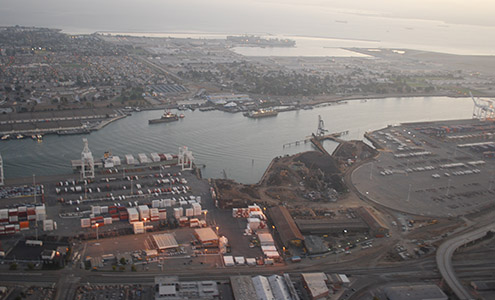Back in '09, I wrote a series of columns on the history of the islands of San Francisco Bay. I now realize that I overlooked several: Alameda, Mare and Bay Farm.

Alameda Island (above) with the Oakland Estuary separating it from the Port of Oakland (below). Photo by Joel Williams
By Captain Ray
Published: May, 2015
Back in '09, I wrote a series of columns on the history of the islands of San Francisco Bay. I now realize that I overlooked several: Alameda, Mare and Bay Farm. The status of all three as islands has sometimes been questioned but, like those who refuse to accept that Pluto is not a planet, we will continue to treat all three as islands. The controversies are simply a part of the history (and geography) of each of these places.
Once upon a time, not so very long ago, Alameda was not an island. But things change and so there is a story to tell.
This area, although not yet an island, for many thousands of years had been part of the Ohlone homeland. The Ohlone (sometimes referred to as the Costanoan) inhabited an area that stretched from the shores of San Francisco Bay south to Monterey Bay and inland to the southern Salinas Valley. By excavating the shell mounds (rubbish dumps) they created, anthropologists date some settlements in the East Bay as early as 4000 BCE. It is interesting to note that they lived in permanent villages, traded and inter-married with their neighbors, and that northern California natives were the only native residents of the Americas that did not incorporate organized warfare into their culture.
When Europeans first arrived on the east side of San Francisco Bay (or contra costa, Spanish for opposite coast), they found the land that was to become Alameda Island quite firmly attached to what we now call Oakland. Early maps bear witness to this attachment, but do show a stream named San Antonio Creek as the boundary between them. Some of the land was marshy and consisted of tidal sloughs, but the higher (and drier) land on both sides of the creek was covered with one of the largest coastal live-oak forests in the world. It is from this forest that Oakland got its name. Alameda was originally called Encinal, Spanish for live oak forest or Encinal de San Antonio. The name Alameda (Spanish for “tree-lined avenue” or “a grove of poplar trees”) was chosen by popular vote when the town of Alameda was founded in 1853.
This (not yet an) island was part of Rancho San Antonio, granted to Don Luis Maria Peralta in 1820 by the last Spanish governor of Alta California. Peralta had come north from Mexico with his parents as part of the de Anza expedition in 1776. As an adult, he served in the Spanish Army and helped found Mission Santa Clara, the Pueblo of San Jose and the Presidio of San Francisco.
This land grant was a reward for Peralta’s many years of service in the Spanish Army. The vast land holding, almost 45,000 acres or 35 square miles, extended from what is now Albany in the north, to San Leandro in the south and Piedmont in the east. The grant also included all the land that is now the cities of Berkeley, Emeryville and Oakland. The Peralta family was able to hold on to the rancho when Mexican rule replaced Spanish in 1821. In 1845, Don Luis divided the rancho among his four sons; Antonio Maria Peralta got most of Oakland and all of Alameda.
With the end of the Mexican War and the signing of the Treaty of Guadalupe Hidalgo, the United States took control of California from Mexico and affirmed the Peralta grant. However, the gold rush, with American settlers usurping his land, rustling from his herds of cattle and horses—coupled with external legal battles and internal family squabbles—began to erode Antonio Peralta’s claim to the land. When he died in 1879, his holdings had shrunk from the 16,000 acres he had inherited to a mere 23 acres. In 1897, Antonio Maria’s daughter Inez Gallindo sold these remaining acres and the time of the Peralta family ended.
Next month I’ll complete the tale of this interesting part of the Bay Area—an area referred to by Mark Twain as “the garden of California”—to explain when and how Alameda became an island.
Ray Wichmann, is a US SAILING-certified Ocean Passagemaking Instructor, a US SAILING Master Instructor Trainer, and a member of US SAILING’s National Faculty. He holds a 100-Ton Master’s License, was a charter skipper in Hawai’i for 15 years, and has sailed on both coasts of the United States, in Mexico, the Caribbean and Greece. He is presently employed as the Master Instructor at OCSC Sailing in the Berkeley Marina.

